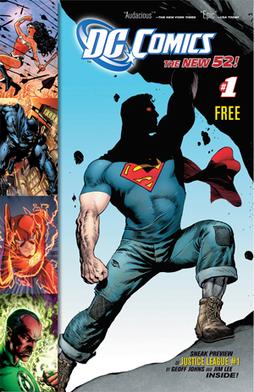
All-American Comics was a comics anthology and the flagship title of comic book publisher All-American Publications, one of the forerunners of DC Comics. It ran for 102 issues from 1939 to 1948. Characters created for the title, including Green Lantern, the Atom, the Red Tornado, Doctor Mid-Nite, and Sargon the Sorcerer, later became mainstays of the DC Comics line.

Batgirl is the name of several fictional superheroines appearing in American comic books published by DC Comics, depicted as female counterparts and allies to the superhero Batman. The character Betty Kane was introduced into publication in 1961 by Bill Finger and Sheldon Moldoff as Bat-Girl, and was replaced in 1967 by Barbara Gordon, who became the iconic Batgirl. The character debuted in Detective Comics #359 by writer Gardner Fox and artist Carmine Infantino, introduced as the niece/adoptive daughter of police commissioner James Gordon.

Barbara Gordon is a superheroine appearing in American comic books published by DC Comics, commonly in association with the superhero Batman. The character was created by television producer William Dozier, editor Julius Schwartz, writer Gardner Fox, and artist Carmine Infantino. Dozier, the producer of the 1960s Batman television series, requested Schwartz to call for a new female counterpart to the superhero Batman that could be introduced into publication and the third season of the show simultaneously. The character subsequently made her first comic-book appearance as Batgirl in Detective Comics #359, titled "The Million Dollar Debut of Batgirl!" in January 1967, by Fox and Infantino, allowing her to be introduced into the television series, portrayed by actress Yvonne Craig, in the season 3 premiere "Enter Batgirl, Exit Penguin", in September that same year.

Gail Simone is an American writer best known for her work in comics on DC's Birds of Prey, Batgirl, Dynamite Entertainment's Red Sonja, and for being the longest running female writer on Wonder Woman to date. Other notable works include Clean Room, Secret Six, Welcome to Tranquility, The All-New Atom, and Deadpool.

Ron Marz is an American comic book writer, known for his work on titles such as Batman/Aliens, DC vs. Marvel, Green Lantern, Silver Surfer, and Witchblade.
Adriana Melo is a Brazilian comic book artist, Colorist, and penciller. She has worked on various Star Wars, Marvel Comics, and DC Comics titles. Notably, she worked on the Star Wars: Empire series. She has also worked on DC Comics' Rose & Thorn and Birds of Prey as well as Top Cow's Witchblade and Marvel Comics's Ms. Marvel. In 2018 she collaborated with writer Gail Simone on a six-issue DC miniseries featuring Plastic Man.

Cully Hamner is an American comic book artist, known for his work on such books as Green Lantern: Mosaic, Blue Beetle, Black Lightning: Year One, and Detective Comics. He is also the co-creator and illustrator of the 2003 graphic novel Red, which was adapted into a 2010 feature film of the same name starring Bruce Willis, as well as a 2013 sequel.

Alexandra DeWitt is a fictional character in the DC Comics Universe. She is the girlfriend of Kyle Rayner before he receives the Green Lantern power ring from Ganthet. She is best known, however, as the murder victim whose manner of disposal led writer Gail Simone to coin the phrase "Women in Refrigerators". DeWitt first appears with Kyle at the end of Green Lantern vol. 3, #48.

Nicola Scott is a comics artist from Sydney, Australia whose notable works include Birds of Prey and Secret Six. In 2016, she and writer Greg Rucka relaunched Wonder Woman for DC Comics Rebirth and created the comic series Black Magick, which was published by Image Comics.
The portrayal of women inAmerican comic books has often been the subject of controversy since the medium's beginning. Critics have noted the roles of women as both supporting characters and lead characters are substantially more subjected to gender stereotypes, with femininity and/or sexual characteristics having a larger presence in their overall character.

"The Circle" is a four-issue comic book story arc written by Gail Simone with art by Terry Dodson and Rachel Dodson. Published in issues #14-17 of Wonder Woman, it marked the first arc by Gail Simone on her run of the book.
In American mainstream comics, LGBT themes and characters were historically omitted intentionally from the content of comic books, due to either formal censorship or the perception that comics were for children and thus LGBT themes were somehow inappropriate. With any mention of homosexuality in mainstream United States comics forbidden by the Comics Code Authority (CCA) until 1989, earlier attempts at exploring these issues in the US took the form of subtle hints or subtext regarding a character's sexual orientation. LGBT themes were tackled earlier in underground comix from the early 1970s onward. Independently published one-off comic books and series, often produced by gay creators and featuring autobiographical storylines, tackled political issues of interest to LGBT readers.

The New 52 is the 2011 revamp and relaunch by DC Comics of its entire line of ongoing monthly superhero comic books. Following the conclusion of the "Flashpoint" crossover storyline, DC cancelled all its existing titles and debuted 52 new series in September 2011. Among the renumbered series were Action Comics and Detective Comics, which had retained their original numbering since the 1930s.
The Hawkeye Initiative is a satirical Tumblr page similar to Women in Refrigerators that comments on the depiction and treatment of female characters and superheroes in comic books. The site features fan art of Marvel character Hawkeye in various poses held by female characters that the artists believe to be impossible or sexually provocative. The site's intent is phrased as "to draw attention to how deformed, hypersexualized, and unrealistically dressed women are drawn in comics". The site further states that these poses are seen as normal and go unnoticed by many readers when performed by female superheroes.
Women in Refrigerators syndrome is a literary trope where female characters are injured, sexually assaulted, killed, or depowered, sometimes to stimulate "protective" traits, and often as a plot device intended to move a male character's story arc forward. The phrase is used to analyze why such plot devices are used disproportionately on female characters.
Historically, the English-language comic-book field has been male-dominated. This has led to rampant sexism and the harassment of female fans and creators in the comics industry.










